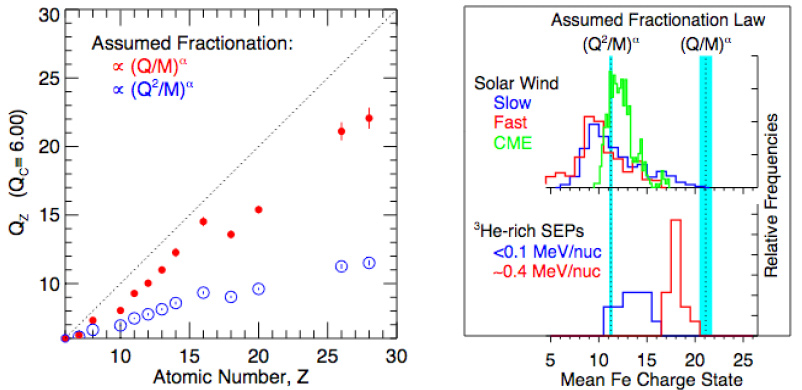
| ACE News Archives | ACE News #120 - Feb 23, 2009 |
Subscribe to ACE News |

Ionic charge states (denoted Q) of energetic heavy nuclei can provide important clues about the temperatures and/or densities in the locations where solar energetic particles (SEPs) are accelerated (see ACE News #90, 99, 107, and 116). Present instrumentation is not capable of measuring Q above an MeV/nucleon, and techniques using the Earth's magnetic field as a filter, while applicable in large gradual (shock acceleration) events, are not useful for the smaller 3He-rich events.
To investigate the origin of 3He-rich events using high-energy (>10 MeV/nuc) observations from the ACE/SIS instrument, we have employed an indirect technique (Cohen et al. 1999) for inferring Q-states based on the measured isotopic and elemental fractionation patterns. Using data from the 3He-rich event of 20 Aug 2002, the largest such event detected during solar cycle 23, it was found that isotopic composition is fractionated relative to solar wind isotopic composition such that the SEP abundance ratio between isotopes of masses M2 > M1 is enhanced as a power law in the ratio of the two masses, (M2/M1)α for some positive constant α. This fractionation could be a consequence of a more-general fractionation law that depends on both Q and M, but with the Q value playing no role when comparing isotopes of the same element. We can adopt a physically reasonable hypothesis for the Q-dependence of the fractionation and work out the implications for the Q-states in the material where the fractionation occurred. Fractionation depending on Q/M has been widely observed in gradual SEP events (e.g. Breneman and Stone 1985) and is probably due to the magnetic-rigidity dependence of the interaction of the ions with the accelerating fields. In addition, the parameter Q2/M plays an important role in stochastic acceleration models because it controls the rate of energy losses by Coulomb collisions. Assumptions that fractionation goes as a power law either in Q/M or in Q2/M have been tried, with the exponent of the power law obtained from the measured isotopic fractionation.
The left-hand figure shows the patterns of Q-states obtained for the 20 Aug 2002 event with these two assumed fractionation laws. In the right-hand figure the two values obtained for Fe (vertical bands) are compared with distributions of Fe Q-states found in the solar wind (Lepri & Zurbuchen 2004), which should be similar to those found in coronal material from which the SEPs are accelerated, and in 3He-rich events at two lower energies where direct measurements were possible (DiFabio et al. 2008). With the assumption of Q/M-dependent fractionation we obtain high values of QFe (>20) that would suggest that the fractionation occurs after the stripping responsible for producing observed increases in QFe below 1 MeV/nuc in many 3He-rich events. The alternative assumption, that the fractionation depends on Q2/M, yields significantly lower QFe values that are similar to those found for the solar wind and for SEPs at energies below 0.1 MeV/nuc. In this case one would conclude that the fractionation occurs before most of the acceleration and stripping. Neither of these possibilities can be ruled out a priori. Application of this technique at energies below an MeV/nuc in events where the results can be compared with direct measurements of QFe may help to resolve this question.
This item was contributed by Mark Wiedenbeck of the ACE/SIS Science Team. Address questions and comments to
Last modified 23 Feb 2009.